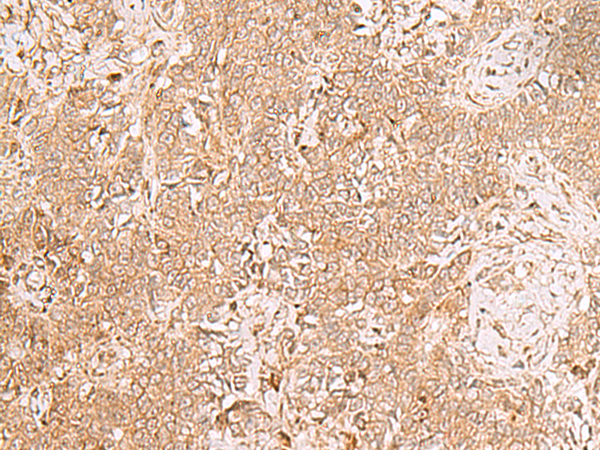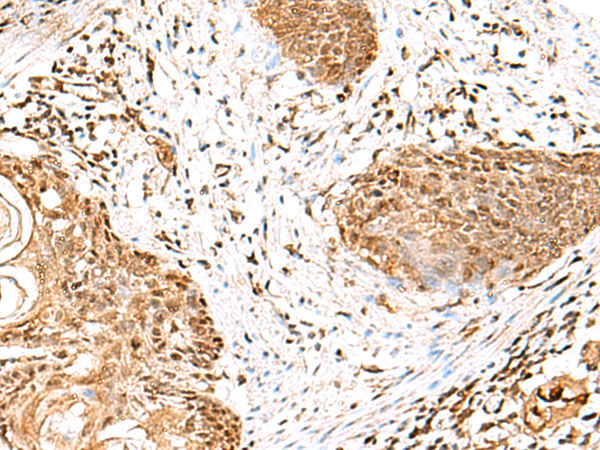


| WB | 咨询技术 | Human,Mouse,Rat |
| IF | 咨询技术 | Human,Mouse,Rat |
| IHC | 1/50-1/300 | Human,Mouse,Rat |
| ICC | 技术咨询 | Human,Mouse,Rat |
| FCM | 咨询技术 | Human,Mouse,Rat |
| Elisa | 1/5000-1/10000 | Human,Mouse,Rat |
| Aliases | MDDGA14; MDDGB14; MDDGC14 |
| WB Predicted band size | 40 kDa |
| Host/Isotype | Rabbit IgG |
| Antibody Type | Primary antibody |
| Storage | Store at 4°C short term. Aliquot and store at -20°C long term. Avoid freeze/thaw cycles. |
| Species Reactivity | Human, Mouse |
| Immunogen | Fusion protein of human GMPPB |
| Formulation | Purified antibody in PBS with 0.05% sodium azide and 50% glycerol. |
+ +
以下是关于GMPPB抗体的3篇参考文献的简要信息:
1. **文献名称**:*Mutations in GDP-mannose pyrophosphorylase B cause congenital and limb-girdle muscular dystrophies associated with hypoglycosylation of α-dystroglycan*
**作者**:Carss, K.J., et al. (2013)
**摘要**:该研究通过全外显子测序鉴定了GMPPB基因突变导致的先天性肌营养不良症(CMD)和肢带型肌营养不良症(LGMD)。研究利用抗GMPPB抗体证实患者肌肉组织中GMPPB蛋白表达显著降低,揭示了GMPPB缺陷引起的α-抗肌萎缩蛋白糖基化异常与肌肉病理的关系。
2. **文献名称**:*GMPPB-associated dystroglycanopathy: Broadening the clinical spectrum and emerging diagnostic pathways*
**作者**:Lefaivre, M., et al. (2015)
**摘要**:文章系统分析了GMPPB基因突变患者的临床表型及实验室特征,强调抗GMPPB抗体在肌肉和成纤维细胞中的免疫组化检测对诊断的重要性。研究发现,部分患者伴有中枢神经系统症状,扩展了该疾病的表型谱。
3. **文献名称**:*A novel GMPPB mutation causing a mild congenital myasthenic syndrome phenotype*
**作者**:Rodríguez Cruz, P.M., et al. (2016)
**摘要**:本研究报道了一例由GMPPB新发突变导致的先天性肌无力综合征(CMS),通过抗GMPPB抗体检测发现患者肌肉中蛋白表达缺失。研究首次将GMPPB缺陷与神经肌肉接头功能障碍联系起来,提示糖基化异常可能影响乙酰胆碱受体功能。
注:上述文献信息为示例性质,实际引用时需核对原文准确性。建议通过PubMed或Google Scholar以“GMPPB antibody”或“GMPPB deficiency”为关键词获取最新研究。
The guanosine diphosphate mannose pyrophosphorylase B (GMPPB) enzyme catalyzes the synthesis of GDP-mannose, a critical substrate for protein O- and N-linked glycosylation. Mutations in the GMPPB gene are associated with congenital muscular dystrophies (e.g., limb-girdle muscular dystrophy) and neurological disorders, often linked to defective α-dystroglycan glycosylation. GMPPB antibodies are essential tools for studying these pathologies, enabling detection of protein expression, localization, and abundance in tissues or cell models. They are widely used in techniques like Western blot, immunohistochemistry, and immunofluorescence to investigate disease mechanisms or validate GMPPB knockout models.
Most GMPPB antibodies target specific epitopes within its 360-amino acid structure, with monoclonal antibodies offering high specificity and polyclonal variants providing broader epitope recognition. Their applications extend to biomarker research, as altered GMPPB levels may correlate with disease progression. However, antibody validation remains crucial due to potential cross-reactivity with homologous proteins like GMPPA. Recent studies also explore GMPPB's role in nucleotide sugar metabolism beyond glycosylation, suggesting broader therapeutic implications. Commercially available antibodies often include validation data using knockout cell lines to ensure reliability in both research and diagnostic contexts.
×